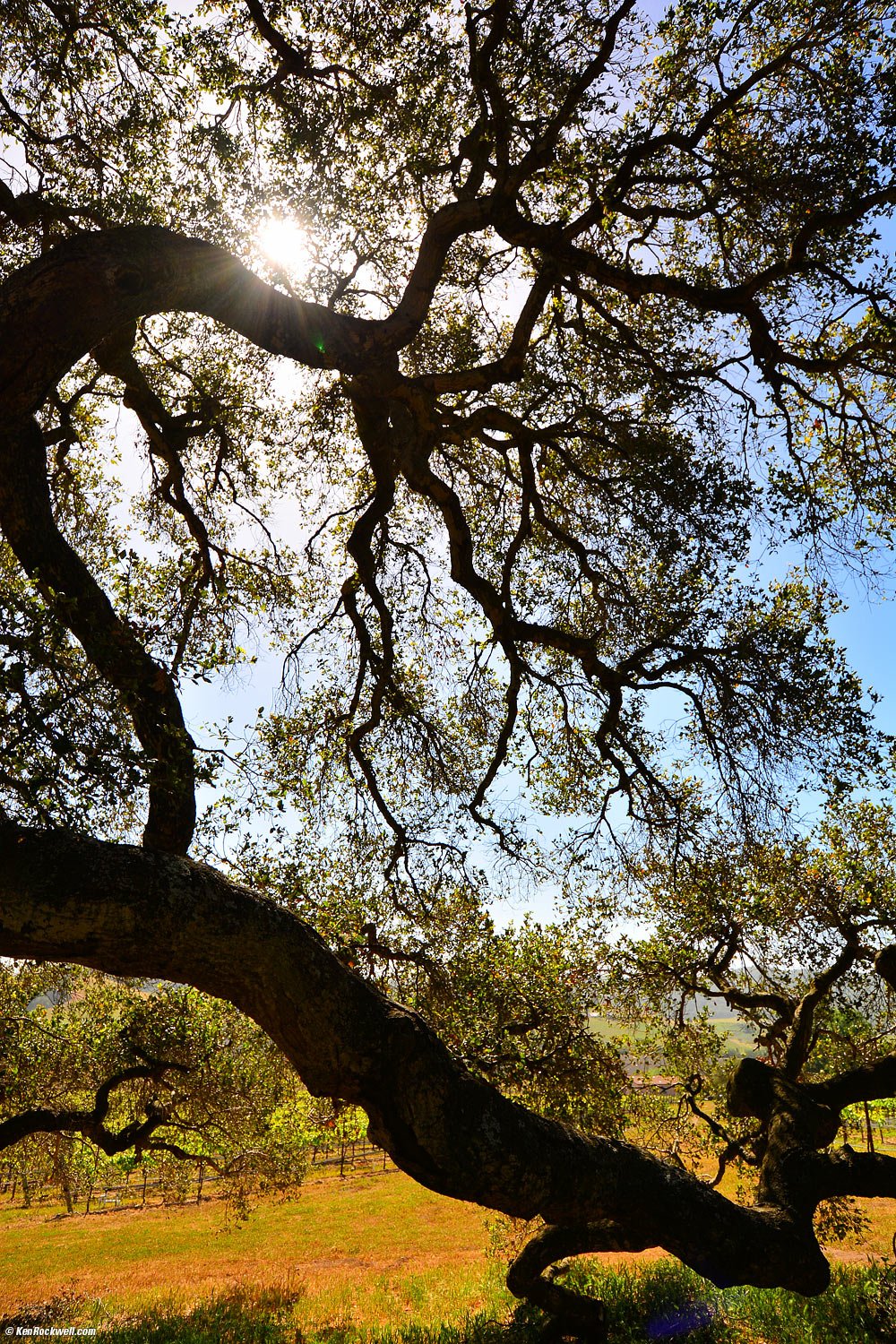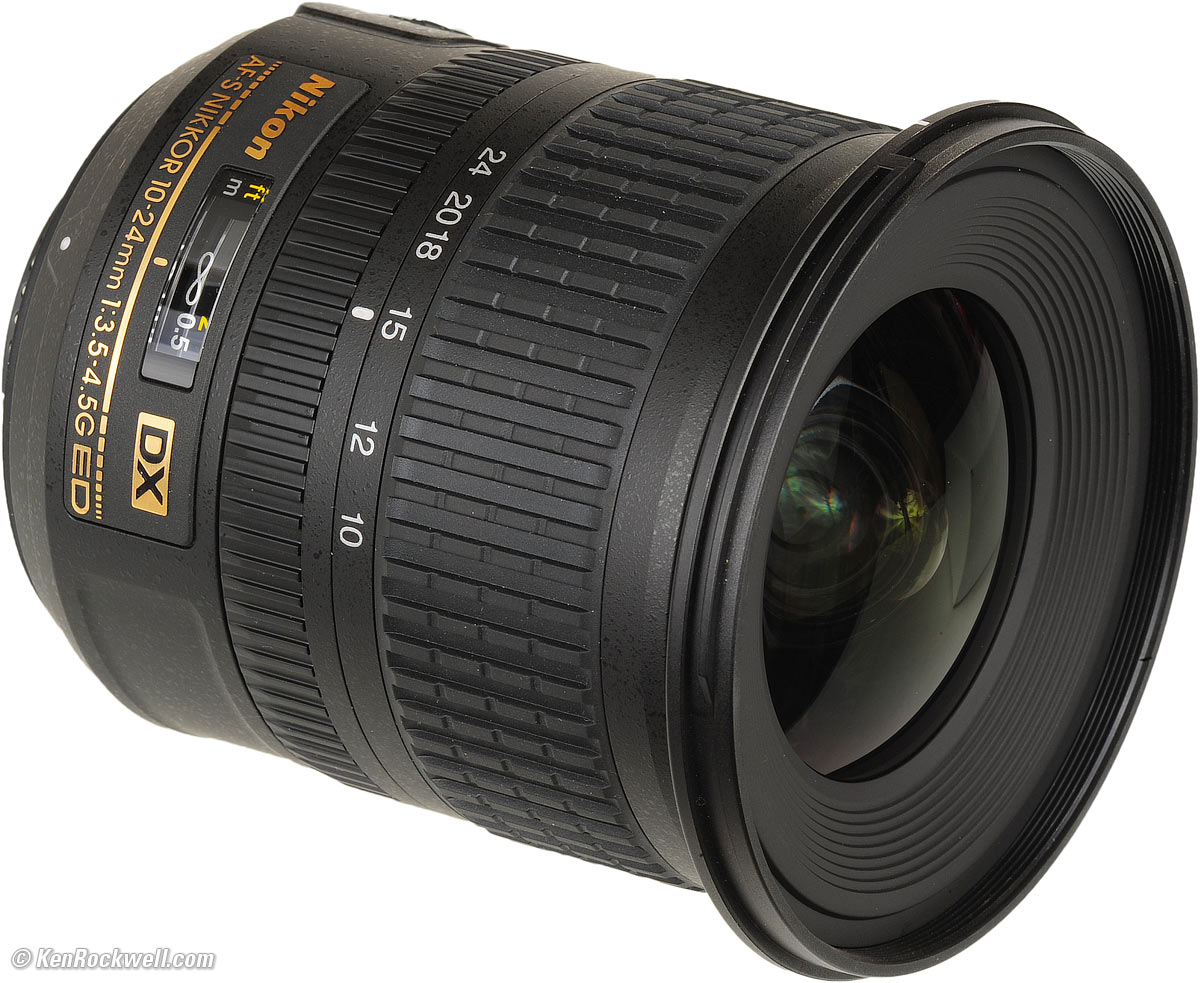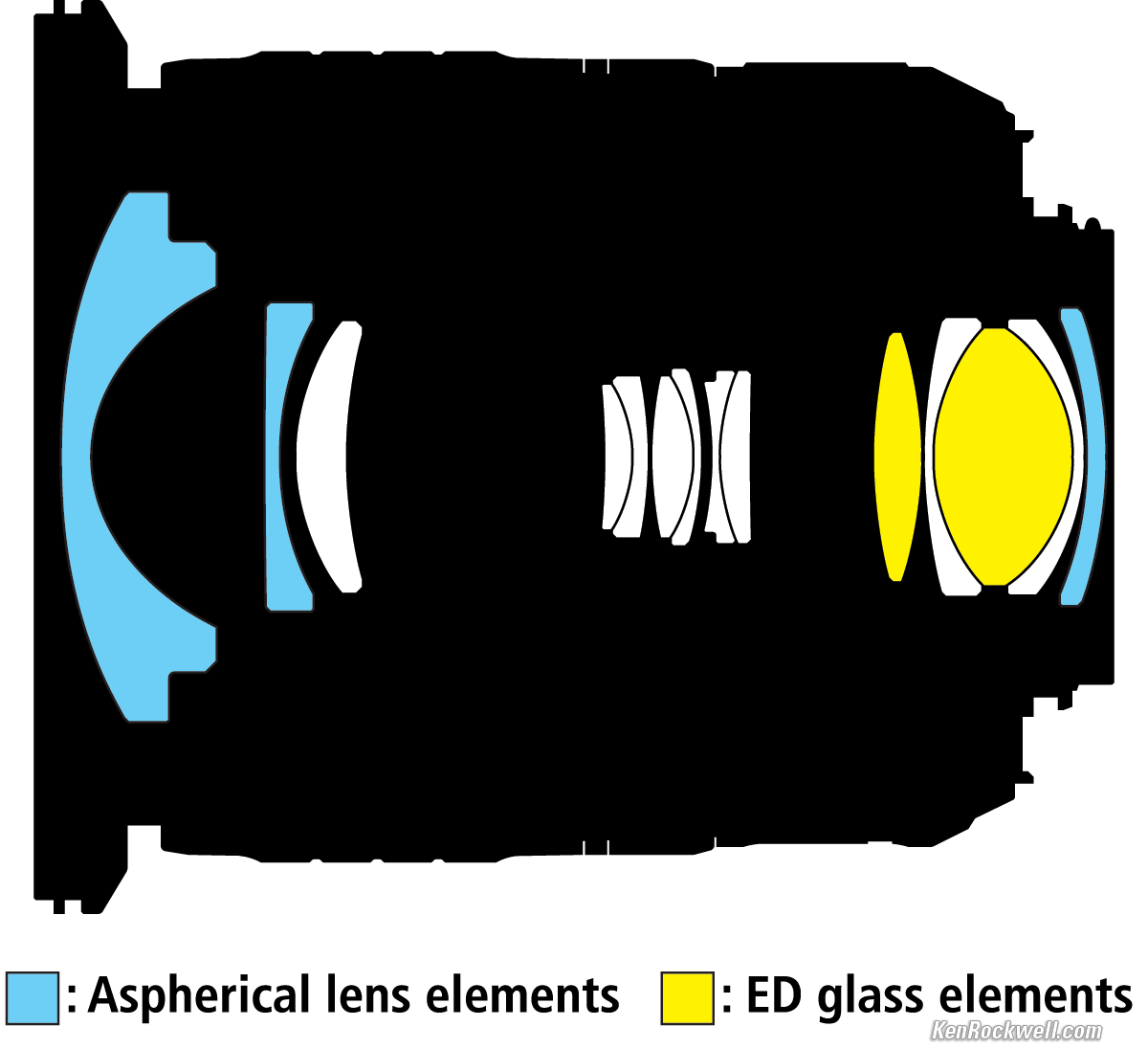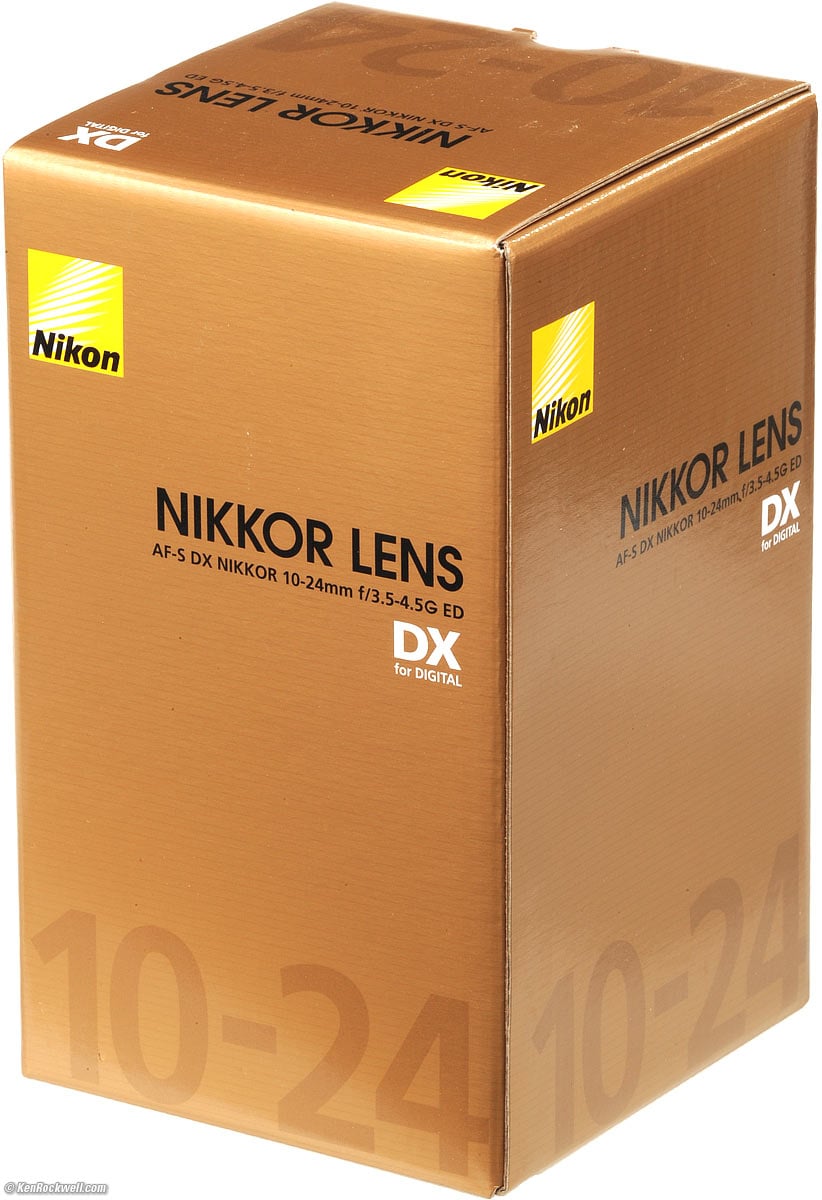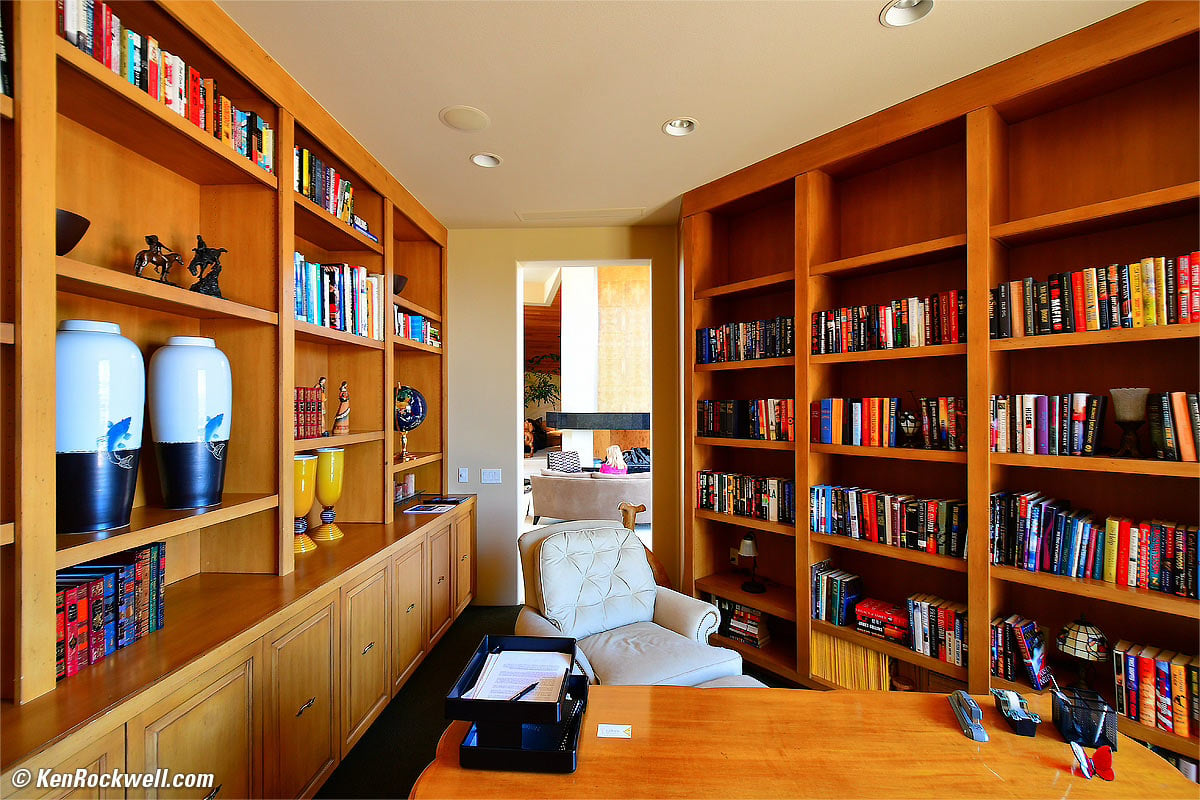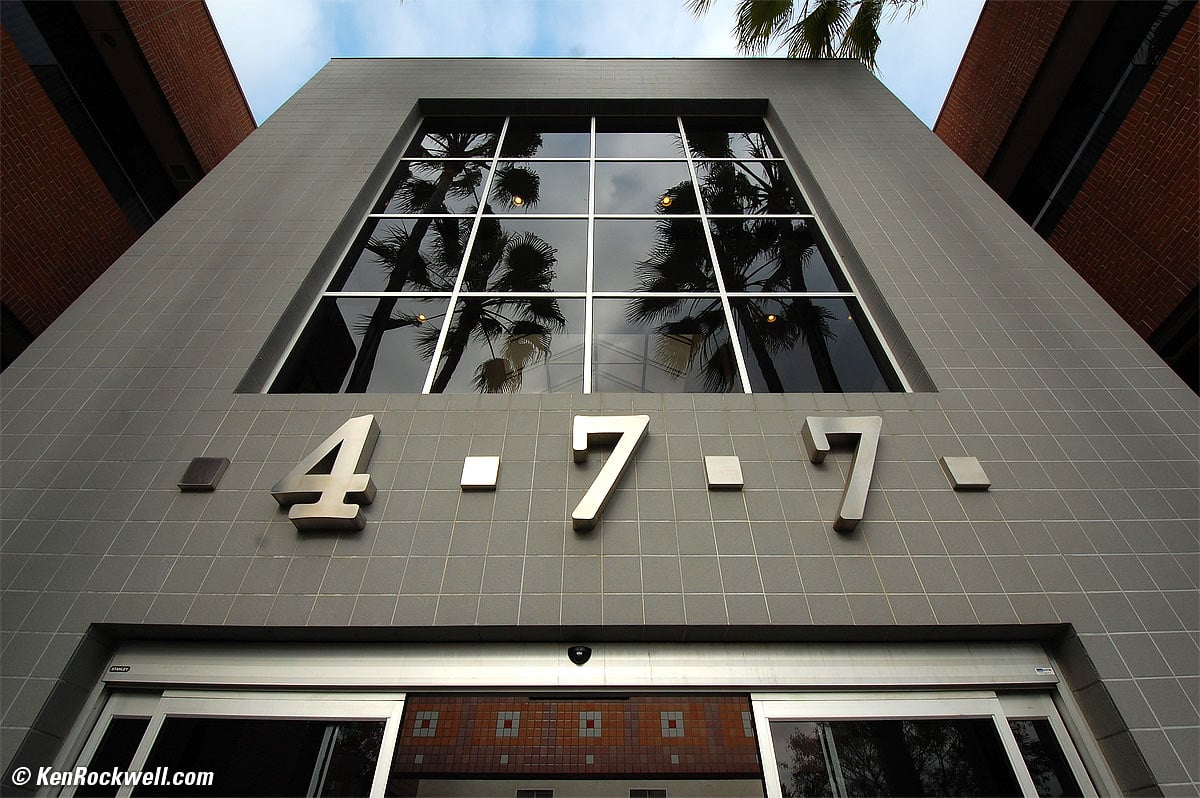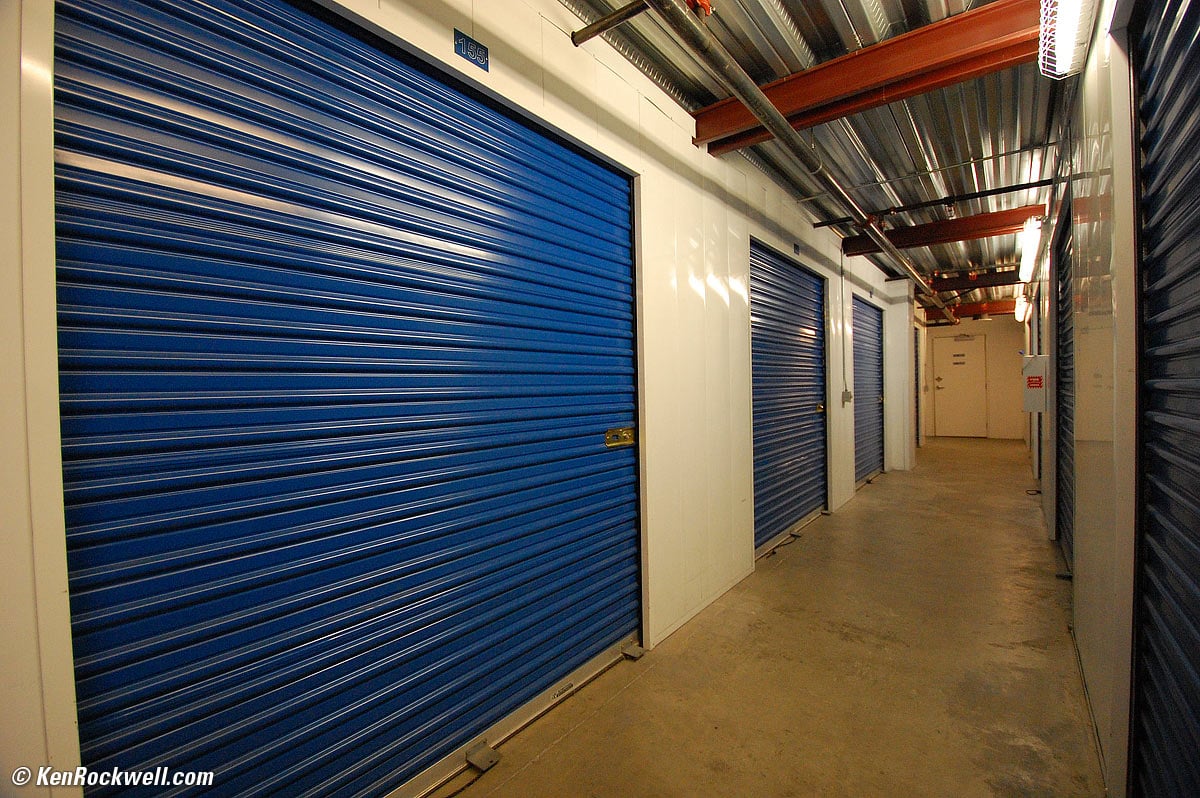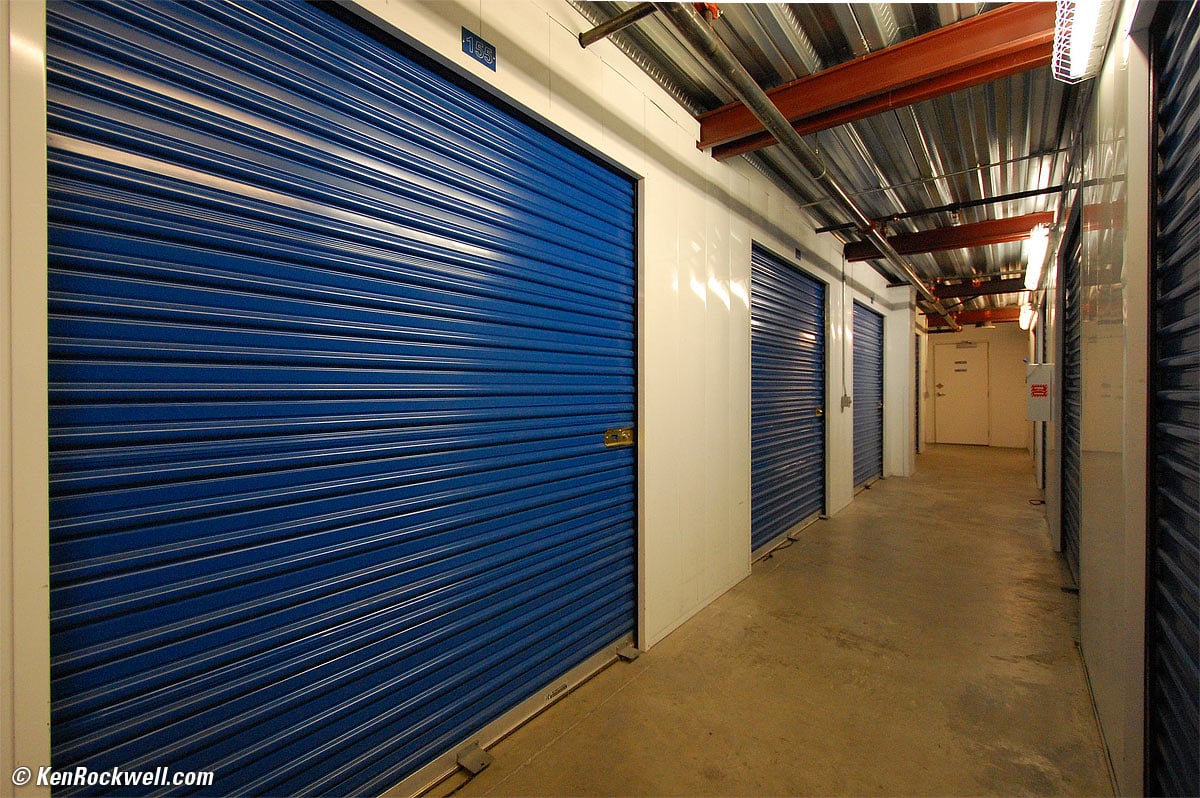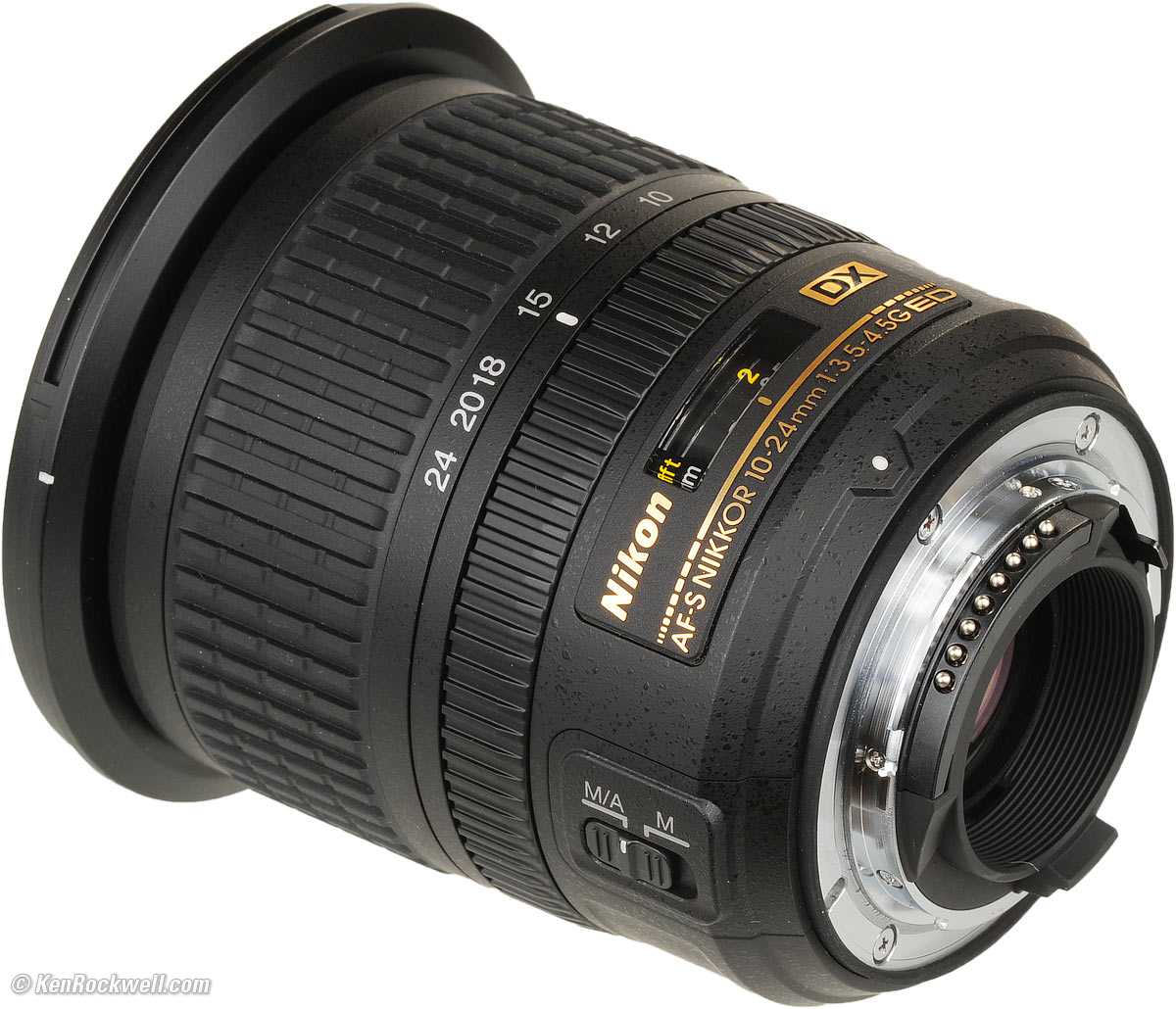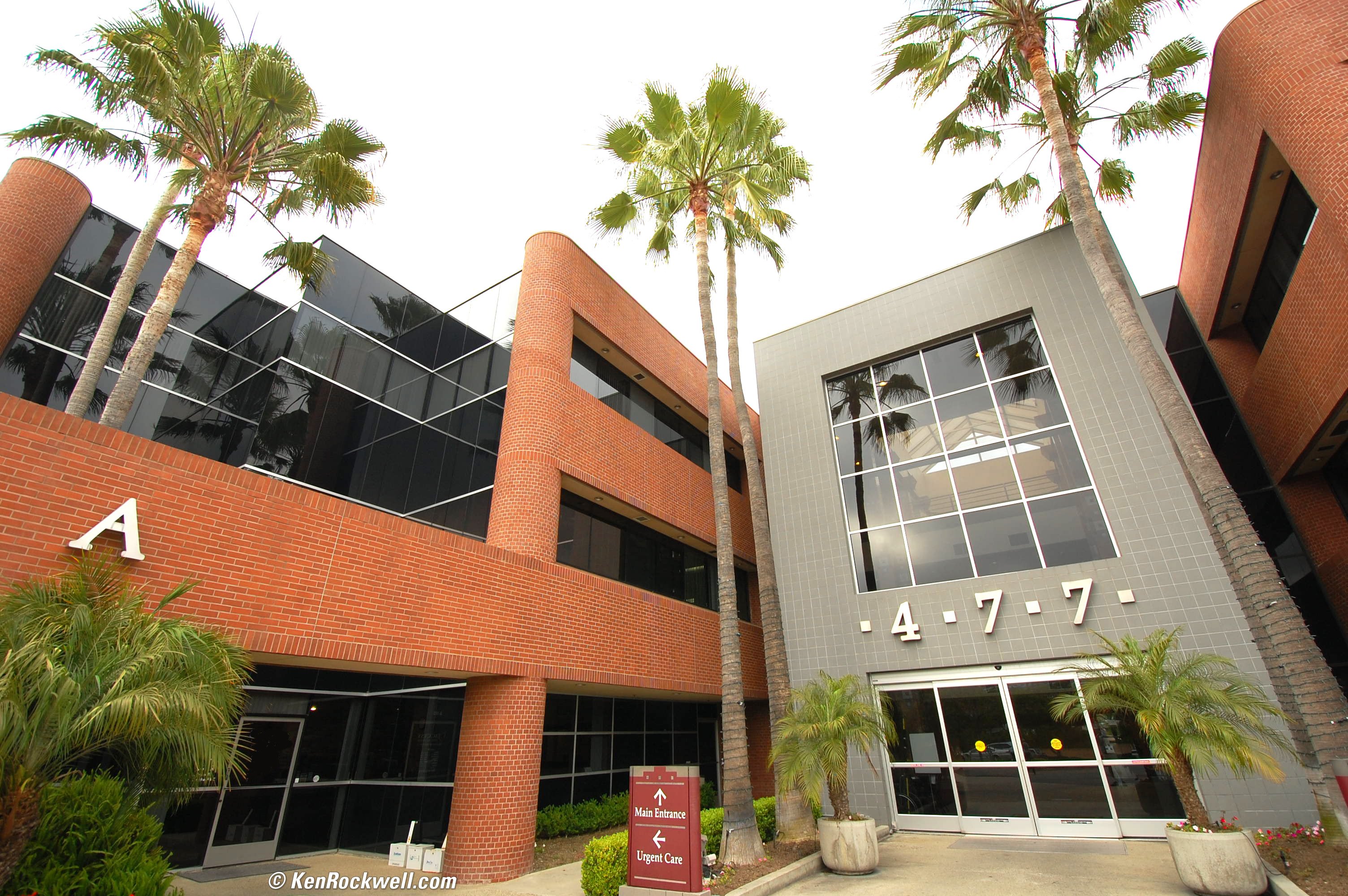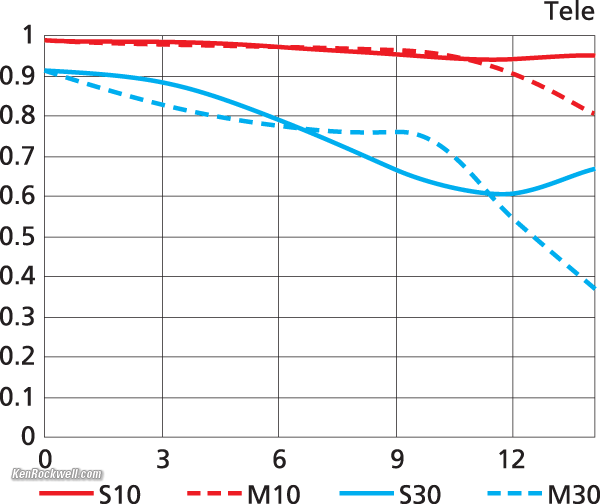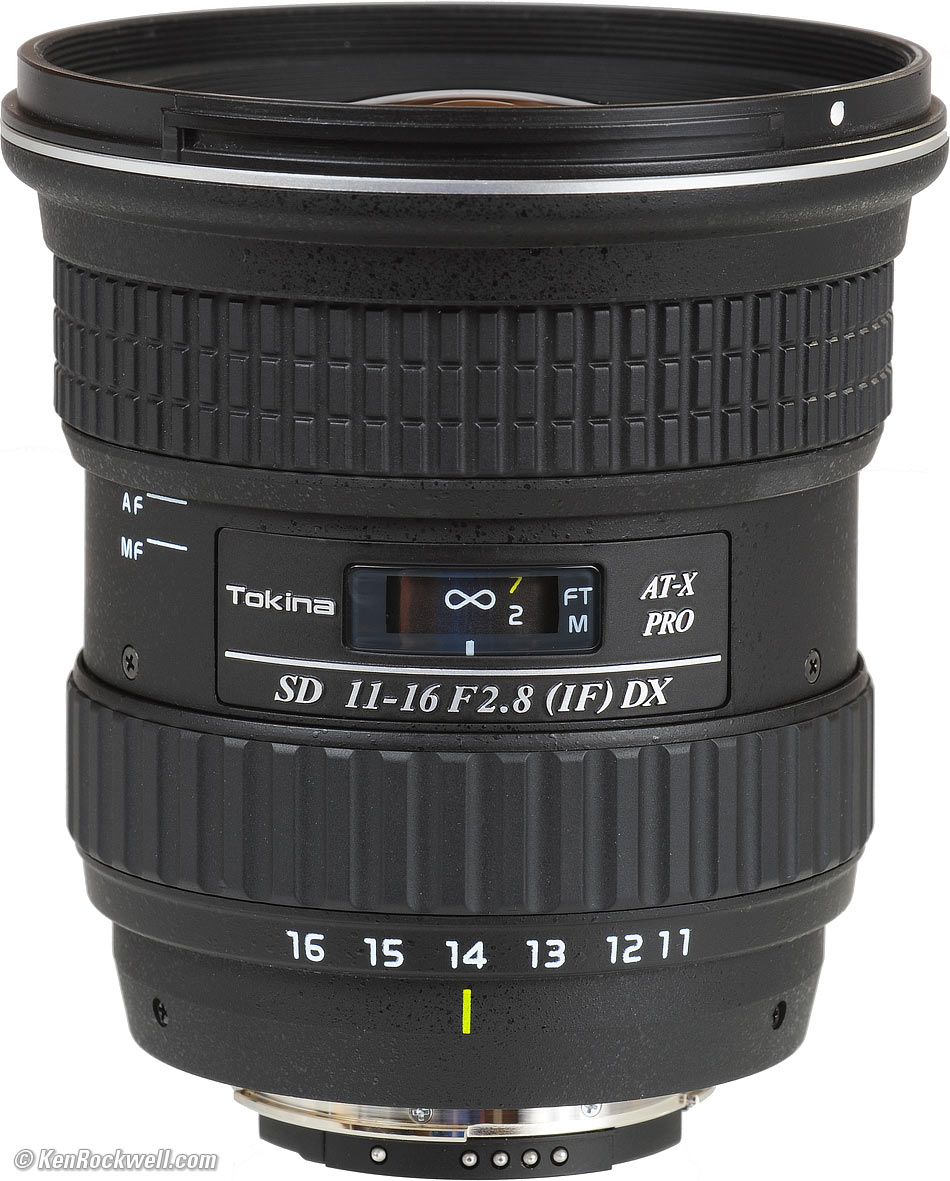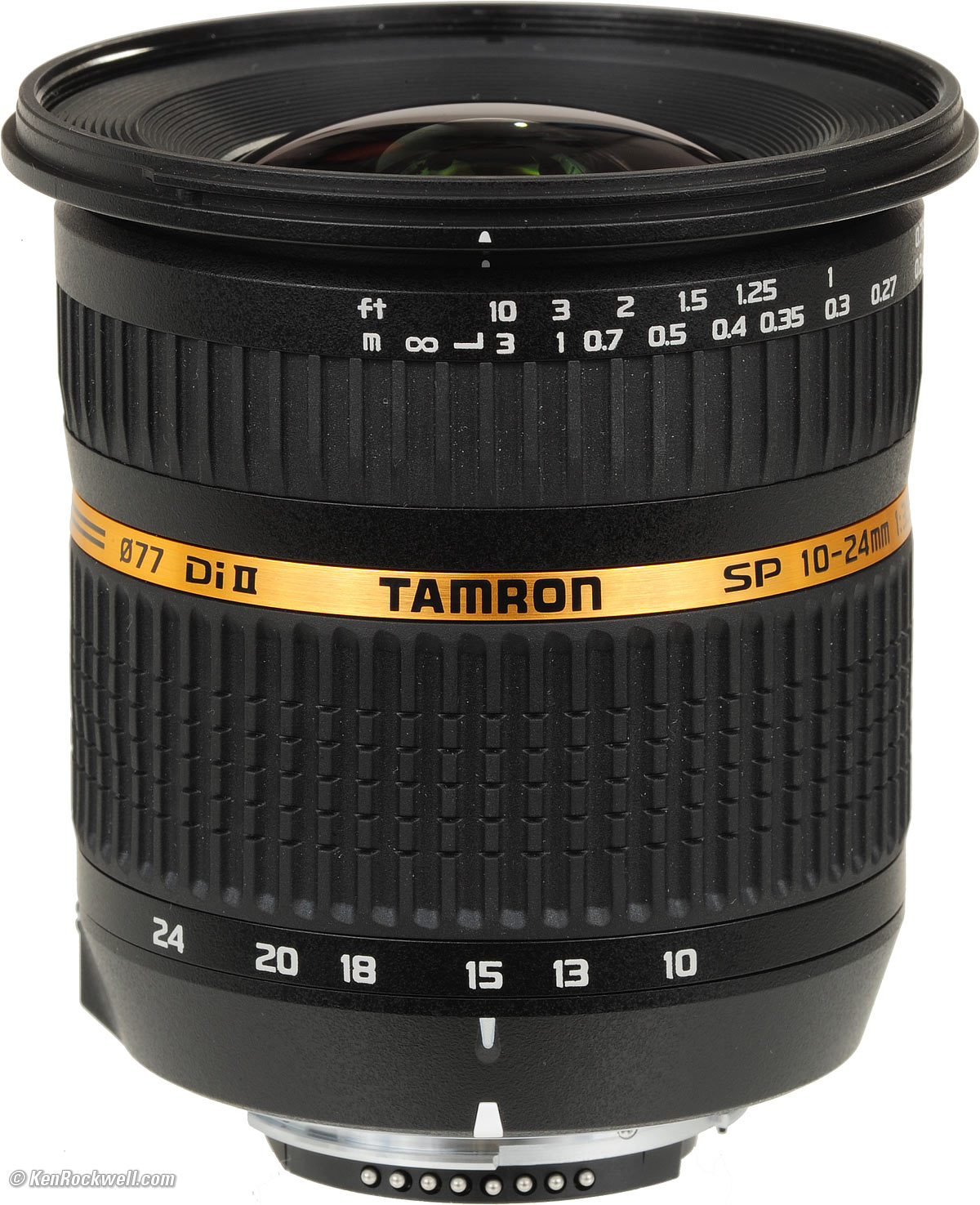Nikon 10-24mm
AF-S Nikkor f/3.5-4.5G DX ED (2009-)
Intro Specs Performance Compared Recommendations
Nikon 10-24mm (77mm filters, 16.3 oz/463g, about $897). enlarge. I bought mine at this link to it at Adorama; this link to it at Amazon and to it at B&H are also excellent places.
This all-content, junk-free website's biggest source of support is when you use those or any of these links to approved sources when you get anything, regardless of the country in which you live. Nikon does not seal its boxes, so never buy at retail or any other source not on my personally approved list since you'll have no way of knowing if you're missing accessories, getting a defective, damaged, returned, store demo or used lens. (My approved sources ship from automated warehouses where no salespeople or lookie-loos can get their greasy fingers on your new lens.) Buy only from the approved sources I use myself for the best prices, service, return policies and selection.
If you want to buy used, they go for about $550 at this link directly to them at eBay (see How to Win at eBay).
Adorama pays top dollar for your used gear, especially the older model 12-24mm f/4 DX.
| Optics: | |
| Mechanics: | |
| Ergonomics: | |
| Usefulness: | |
| Availability: | |
| Overall: |
Ideal Uses: Perfect for use on every DX digital Nikon. Part of Nikon's DX Dream Team.
Not for: FX or film cameras.
July 2017 Nikon Reviews Nikon Lenses All Reviews
NEW: Nikon 10-20mm. A third the price & a fraction of the weight, but with a plastic lens mount and only works on newer cameras. Highly recommended.
Sample Image
Oaks, Kynsi, San Luis Obispo. 10:31 AM, 14 April 2013. bigger. (2013 Nikon D7100, 2009 Nikon 10-24mm G at 15mm, f/8 at 1/250 at ISO 100, built-in flash fired to no effect, Perfectly Clear.)
Introduction top
Intro Specs Performance Compared Recommendations
The Nikon 10-24mm f/3.5-4.5G ED is Nikon's best and newest ultrawide zoom for Nikon DX cameras.
It's not intended for film or FX cameras, but in a pinch, it works from about 18mm-24mm on them.
The Nikon 10-24mm is very sharp. It's reasonably resistant to ghosts but has a healthy dose of distortion, especially at the wide end.
Compared to the 12-24mm, the 10-24mm is more cheaply built. The 12-24mm was built to semi-pro standards, but this new 10-24mm feels more dinky and I suspect will break if you bang the front of it into anything hard enough. Hey, few people really need lenses that will last 75 years; if you do, you can still buy brand-new manual-focus AI-s lenses that will last longer than any of us.
Focus is easy: just grab the ring at any time for instant manual focus override, and if you do, you get back to autofocus as soon as you tap the shutter button.
How important is 10mm versus 12mm? I'm all about wide. 10mm lets you get closer to create images with deeper perspective and even more power than the 12mm end of the 12-24mm. Sharpness, distortion and all that mean nothing compared to the superior point-of-view you can get with a wider lens.
I don't know about you, but every shot I make with my 12-24mm is at the 12mm stop. Hooray for pushing that back to 10mm! These two silly little millimeters are everything; everything else is far less important than the stronger images I can make with those two less millimeters.
This is a great lightweight lens, but it's expensive. I'd also very seriously consider the Tokina 11-20mm f/2.8 DX which sells for less and is better made. If speed, build quality and price matters, get the Tokina. If zoom range matters, get this 10-24mm.
Compatibility back to intro back to top
Everything works perfectly on every DX digital Nikon, and especially on Nikon's cheapest D40, D40x, D60 and D5000.
If you use it on film or FX you'll get just a circular image in the center a10mm, marginal results at 15mm and perfectly fine results from 18-24mm.
Nikon 10-24mm. enlarge.
Specifications top
Intro Specs Performance Compared Recommendations
Name
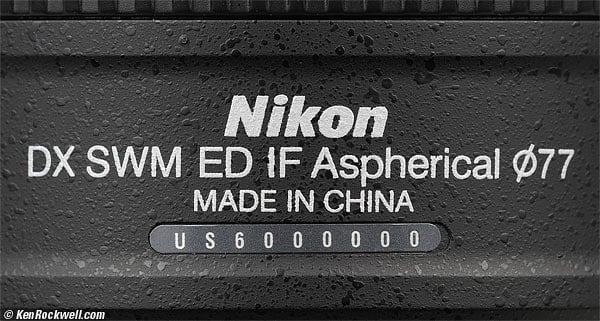
Nikon 10-24mm bottom ID.
Nikon calls this the Nikon AF-S NIKKOR 10-24mm f/3.5-4.5G DX SWM ED IF Aspherical.
AF-S and SWM: Silent Wave (focus) Motor.
G: Gelded for cost-reduction and removing compatibility with older cameras.
DX: Won't work well on film or FX cameras.
ED: Magic ED Glass.
IF: Internal Focusing.
Aspherical: Aspherical elements.
Optics top
Schematic diagram. enlarge.
14 elements in 9 groups.
Two of them are magic ED glass.
Three of them are aspherical.
It's multicoated, which Nikon calls Nikon Super Integrated Coating.
Coverage top
|
Adorama pays top dollar for your used gear. I use these stores. I can't vouch for ads below.
|
DX only, not film or FX.
Focal Length top
10-24mm, which on a DX camera gives angles of view similar to what a 15-35mm lens gives when used on an FX or 35mm camera.
Close Focus top
0.8 feet (0.24m).
In manual focus, it gets as close as 0.7 feet (0.22m).
Maximum Reproduction Ratio top
1:5.
Hard Infinity Focus Stop? top
No.
You have to let the AF system focus for you at infinity.
Focus Scale top
Yes, barely.
Depth-of-Field Scale top
No.
Infra-Red Focus Index top
No.
Diaphragm top
7 straight blades.
Stops down to f/22-29.
Aperture Ring top
No.
Filter Thread top
77mm, plastic.
Does not rotate.
Size top
Nikon specifies 3.25" (82.5mm) extension from flange by 3.43" (87mm) diameter.
The 10-24mm is shortest at the 15mm setting. It's longest at the 24mm setting.
Weight top
16.320 oz. (462.7g), naked.
Nikon specifies 16.2 oz. (460g).
The 12-24mm measures 16.240 oz. (460.4g), or within 1/10 of a ounce (3g) of this new lens.
Caps top
Nikon throws in one of it's superb 77mm front caps and a classic LF-1 rear cap.
But wait — the best just got better!
Nikon's front caps have been the best in the industry since they moved to their "pinch" style cap about 2000. They are so good — big, chunky, and easy to grab from any angle — that I buy and use them on my Canon lenses!
The Nikon front cap is worlds beyond anything from Zeiss, Contax or Leica. I even buy fake Nikon caps to fit the 55mm threads of some of my Leica lenses since Nikon makes no 55mm caps!
I thought one of you folks was pulling a gag on me, but I kid you not: the made-in-Thailand 77mm front cap that came with my 10-24mm now has a strip of black sandpaper-like grip material glued onto each inner pinch surface.
Holy Guacamole! You'll never have one of these slip off your fingers and fall into Tiger Jumping Gorge.
Hood top
HB-23 plastic bayonet hood included.
Case top
CL-1118 sack is included.
Made in top
Red China.
Don't like it? Then buy Leica, Schneider or Angénieux.
Introduced top
14 April 2009
Available Since top
Photographers first got this 10-24mm in their hands on 15 May 2009.
Nikon Product Number top
2181.
Packaging top
Box, Nikon 10-24mm. enlarge.
Gold-colored corrugated box.
Brown corrugated innards.
Hood and carry pouch sit in a single-wall white cardboard box in a corrugated sub-support above the lens.
The 10-24mm lens sits in a thin foam plastic bag with a matching serial number. Collectors note: when reselling this item, you must have matching numbers on the box, lens and the internal bag!

Packing material with matching serial number!
Price, USA top
$897, Christmas 2015 ~ July 2017.
$710, February 2015.
$810, 06 April 2014.
$659 on sale, 01 April 2014.
$810, May 2013.
$820, November 2012.
$800, November 2010.
$810, March 2010.
$800, July 2009.
$840, June 2009.
$900 at introduction, May 2009.
Performance top
Intro Specs Performance Compared Recommendations
The Nikon 10-24mm is sharp and focuses and handles well.
It has plenty of barrel distortion at 10mm, but only if you place straight lines along the edges.
At 10mm, it is so wide that it sees more than 90º horizontally. If you want, you can look down both hallways at once:
Walnut Creek Embassy Suites (by the railroad tracks), June 2009. bigger.
Distortion performance top
The Nikon 10-24mm f/3.5-4.5G DX AF-S has a healthy amount of distortion. Modern Nikons all correct for this automatically:
Fine home, June 2016. Nikon D500, Auto Distortion Correction ON, Nikon 10-24mm at 10mm, f/3.5 at 1.8 at Auto ISO 160. bigger.
If you're using an old camera it is more difficult to correct; pray for a DxO module.
Most people will never see lens distortion unless they are shooting brick walls. For instance, the distortion is invisible in this shot:
Distortion at 10mm. enlarge.
The distortion is invisible because it mostly affects lines running parallel to the edges. If lines run across the frame or through the center as they do here, distortion doesn't affect them much.
Distortion is only visible if you go out of your way to put straight lines along the frame edges, like this:
Eastside Apartments, Chula Vista, California. enlarge.
This snap was made at 10mm on a D40, Program chose f/3.5, Auto ISO chose 1/125 at ISO 1,600.
In cases like this, the straight lines along the left and right sides look crooked because distortion affects them the most, there is another straight line (the frame edge) against which to compare them, and I didn't hold the camera level in the first place.
This can be corrected by plugging these figures into Photoshop's lens distortion filter. These aren't facts or specifications, they are the results of my research that requires hours of photography and calculations on the resulting data.
| On DX at 10' (3m) |
Visible Effects |
|
10mm |
strong barrel |
+4.5* |
12mm |
Barrel |
+1.5* |
15mm |
slight pincushion |
-0.2* |
18mm |
minor pincushion |
-1.2* |
20mm |
pincushion |
-2.0* |
24mm |
pincushion |
-2.0 |
© 2009 KenRockwell.com. All rights reserved.
| On FX and film at 10' (3m) | Visible Effects |
|
10mm |
black corners |
- |
12mm |
black corners |
- |
15mm |
strong barrel, dim corners |
+3.25 |
18mm |
very slightly wavy |
+0.25* |
20mm |
mild pincushion |
-1.0* |
24mm |
Pincushion |
-2.0 |
© 2009 KenRockwell.com. All rights reserved.
*Slightly wavy after correction
These figures are at 10 feet (3 meters). Distortion tends more towards stronger barrel when you get closer.
Here's the shot of the apartment block after fixing the lens distortion (and sloppy camera work) in Photoshop:
After easy rectification in Photoshop's lens distortion filter. enlarge.
Not to worry, even Nikon's cheapest D3300 today corrects for all this automatically.
Ghosts performance top
It's reasonably free from ghosts. You really have to do something crazy to get any flare or ghosts. This bare bulb was about a foot away from my camera with a long exposure wide-open at high ISO in a dark restaurant.
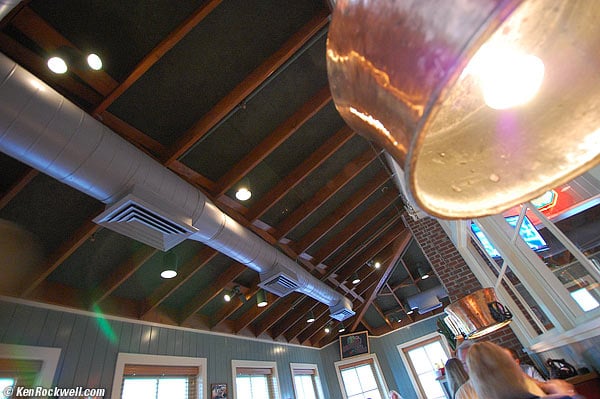
Ghosts, at 10mm f/3.5. D40 at ISO 1600 and 1/8 second.
Lateral Color Fringes performance top
On a Gen 1 camera like the D40 and D200, there is just a little magenta-green in the corners, not enough to worry about.
On a Gen 2 camera like the D90 and D300, there are none.
Mechanics and Construction performance top
If you appreciate only the finest, then go buy Leica. Their 16-21mm f/4 zoom costs a mere $5,995 and is a pain to shoot through a separate viewfinder, both of which you have to zoom manually to the same setting!
If you want to get out and make stunning photos, then shoot Nikon and don't worry if the lens might fall apart after only 20 years of hard use. So what if it's made in China? So is everything else decent today, like Nikon's brilliant 50mm f/1.4 AF-S and 35mm f/1.8 AF-s lenses. If this was built as well as Nikon makes its manual-focus AI-s lenses, it would cost $3,995.
This 10-24mm is a bit more plasticy than the older 12-24mm, mostly because it's a pumper zoom (the front moves in and out) instead of a zoom which extends inside a tough, fixed outer barrel as does the 12-24mm.
This 10-24mm sells for $900 as a new model, and the old 12-24mm sells for the same $900, but as a discounted lens. If you want a tougher lens, get the 12-24mm instead.
Rear, Nikon 10-24mm. enlarge.
Barrel Exterior
Plastic.
Filter Threads
Plastic.
Hood
Plastic bayonet.
Focus Ring
Plastic.
Zoom Ring
Solid plastic.
Zoom Cams
Seem like alloy.
Depth-of-Field Scale
None.
Internals
Seem like metal.
Aperture Ring
None.
Mount
Dull-chromed brass.
Markings
Paint.
Identity Plate
Metal-looking plastic thing.
Serial Number
Sticker.
Ass-Gasket (rain seal at mount)
Yes.
Noises When Shaken
Mild clicking from the diaphragm blades and actuation system.
Quality
Made in People's Republic of China.
Weakness
The front section pumps in and out while zooming, meaning if you hit the from of the lens, you're banging the optics and zoom followers themselves.
This is a much weaker lens mechanically than the 12-24mm, whose outer barrel isn't directly connected to the optics.
Sharpness performance top
Snapshot at 10mm at f/5.6 on a D40. enlarge.
The Nikon 10-24mm is sharp, even wide-open.
It's worlds better than the nasty Tamron 10-24mm, which is far softer.
The only way to make it unsharp is to look in the very farthest corners at 10mm at f/3.5. Even there, it's sharp if you stop down a little.
Sunstars performance top
Snapshot at 10mm at f/11 on a D40. enlarge.
The Nikon 10-24's 7-bladed diaphragm give 14-pointed sunstars.
The blades are a little curved, so the star points are broader as seen here, and not sharp daggers as more often seen on 1980s lenses.
Survivability performance top
Beware banging the front of the lens. If you do, I'll bet you'll crack the zooming system.
Beware that this lens will suck dirt, dust, chemical and biological elements into your camera as it pumps in and out.
I suspect that this lens will have a smaller percentage of good working samples left after 20 years than Nikon's pro lenses.
Then again, screw me. The toughest Nikon lens made in a long time, the 17-35mm f/2.8 AF-S, has none of these issues and zooms protected behind your filter inside a tough magnesium alloy barrel, but mine broke its zoom cam all by itself and broke its AF motor, too, all under warranty.
Rated MTF performance top
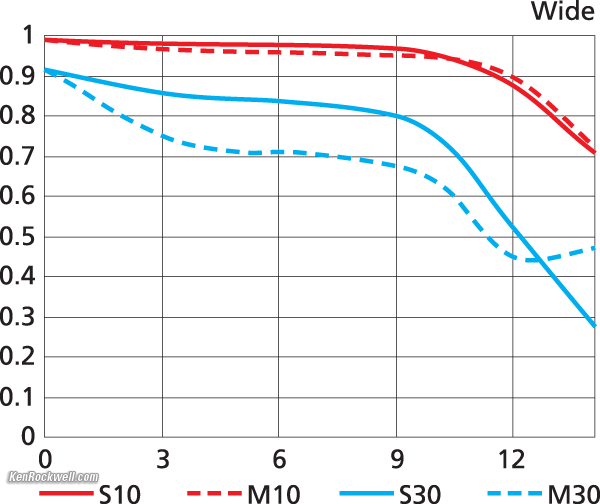 |
|
MTF at 10mm at f/3.5. bigger. |
MTF at 24mm at f/4.5. bigger. |
Comparisons top
Intro Specs Performance Compared Recommendations
Nikon 12-24mm Tokina 11-16mm Tamron 10-24mm Distortion Table
NEW: Nikon 10-20mm. Less than half the price & a fraction of the weight, but with a plastic lens mount. Highly recommended.
Compared to the Nikon 12-24mm DX Compared
Nikon 12-24mm and this 10-24mm. enlarge.
Both lenses weigh within 1/10 of a ounce (3g) of each other, both take the same pro 77mm filters, both are the same size (the 10-24mm gets longer as zoomed, while the 12-24mm stays the same size as seen here). Both focus in exactly the same way with exactly the same cameras. Both have about the same coverage if you do the nasty and try them on FX or film.
10-24mm |
||
| Filter | 77mm |
77mm |
| Weight | 16.240 oz/460.4g |
16.320 oz/462.7g |
| Zoom feel | Smooth and precise |
A little plasticy |
| Manual and Auto Focus | The same |
The same |
| Sharpness | The same |
The same |
| Distortion | Complex |
A little more |
| Changes length as zoomed? | No |
Yes |
| Made in | Japan (maybe elsewhere today) |
China |
| Toughness | Semi-pro |
Good consumer |
| Ass-Gasket? | No |
Yes |
| Price, 5/09 |
Which is better?
The 12-24mm seems tougher if you beat on your gear, but I'm all about getting wider. To me, there is no question that the 10-24mm is the lens to get today.
Should you throw your 12-24mm away and get this new 10-24mm? If you usually shoot your 12-24mm at the 12mm stops as I do, of course.
If you try to compare sharpness, you'll go crazy because each lens renders different pare of the field (radius) and zonally (theta) differently. This is because these lenses are made by man, not God, and mechanical and manufacturing tolerances are such that the glass wiggles around a little from shot to shot, and as you focus and as you zoom. On one shot you'll see one of these two lenses as better, and on the next shot (or on the other side), the other will win.
That's right: on some shots the 10-24mm is sharper on the left while the 12-24mm is sharper on the right, and on the next duplet of shots, the effect reverses, even when all this is done on a tripod.
These lenses are closer to each other in performance than they are from shot-to-shot or side-to-side, so you can not simply post enlarged crops from any two shots and see anything meaningful.
See also Is It Worth It.
Compared to the Tokina 11-16mm f/2.8 top
Tokina 11-16mm f/2.8. enlarge.
Versus the Tokina 11-16mm?
Easy choice: if you have a low-end Nikon that can't autofocus with the Tokina 11-16mm, get the Nikon 10-24mm which will autofocus. That means for the D40, D40x, D60 and D5000, you get the Nikon without question.
The Tokina is faster, built better and costs less, but it won't autofocus on many cameras.
If you have a heavy DX camera that can autofocus with the Tokina, like the D300, D200, D2X or D1X, I'd get the Tokina.
For midweight DX cameras that can AF with the Tokina, like the D50, D70/s, D80, D90 and D100, it's a toss up over your need for speed (f/2.8) versus your tolerances for weight, distortion, physical toughness and price.
In addition to autofocus with light cameras, the other gotcha with the Tokina is that it usually takes a while to get one after you order it. It is very popular because it is in many ways a better lens then either of the Nikons, and costs less.
Features
Nikon 10-24mm |
||
| Autofocus on D40, D40x, D60 and D5000? | Yes |
No |
| Autofocus with every other Nikon? | Yes |
Yes |
| Filter | 77mm |
77mm |
| Weight | 16.320 oz/462.7g |
19.315 oz/547.5g |
| Diaphragm Blades | 7 |
9 |
| Ass-Gasket? | Yes |
No |
| Changes length as zoomed? | Yes |
No |
| Made in | China |
Japan |
| Toughness | Good consumer |
Semi-pro |
| Price, 5/09 | ||
| Availability, 5/09 | Usually in stock |
Rarely in stock |
Specific Recommendations
| For the | Get the |
| D40, D40x, D60 and D5000 | Nikon 10-24mm |
| D300, D200, D1X/h, D2X/h | Tokina 11-16mm |
| D50, D70/s, D80, D90, D100 | Flip coin: Tokina is tougher, heavier, faster and costs less; Nikon goes wider and more likely to be compatible with future Nikons. It's more likely you'll be able to find the Nikon 10-24mm in stock; you'll probably have to wait a month to get the Tokina after you order it because it is rightly popular. |
| FX Cameras | 14-24mm f/2.8 or 17-35mm f/2.8 |
| Film Cameras | 17-35mm f/2.8 |
These comparisons are regardless of price. If you're concerned about price, get the Tokina if it autofocuses on your camera (it will AF on old cheap Nikon digitals like the D100, D50 and D70), but I'd still go for the Nikon 10-24mm for my D40 or other lightweight or other cameras with which the Tokina won't AF.
This is fun: neither Nikon nor Tokina send me any Christmas cards, so I'm probably the only guy who can say it like it is. Yes, the Tokina is better made than the Nikon for less money, but it's heavier, tough to get and may not autofocus on your favorite camera.
Compared to the Tamron 10-24mm top
Forget this Tamron.
The Tamron 10-24mm used to have bragging rights that it was the broadest-ranged ultrawide (10-24mm), and that it offered autofocus on cheap Nikons, but it was way too soft.
Now that Nikon has the same range in a lens that's sharp, we can forget about the Tamron.
Yes, maybe I got a soft one, but the Tamron I borrowed came straight from Tamron's PR dept, unlike the rest of these lenses which I either had to buy myself (Nikon lenses) or was loaned by another reader (Tokina 11-16mm).
Contrary to what I thought as a kid, the most beat-up and defective gear comes from loans directly from manufacturers! Who knows how good or bad the Tamron is. I do know I always opt for the camera-brand lens when I have the chance, since it costs the least long-term.
Distortion Comparison top
Here are the figures I've measured for each.
All these lenses have about the same amount of distortion,
The real difference is in whether or not it's simple and trivial to correct in Photoshop's lens distortion filter, or will require more advanced tools, like DxO.
On DX at 10' (3m):
|
Nikon 10-24mm |
||||||
10mm |
+4.5* |
- |
- |
- |
+ 2.0 to + 5.0** |
+3.5 |
- |
11mm |
- |
+4.0 |
- |
+3.0 |
|||
12mm |
+1.5* |
+3.0* |
+4.0 |
+ 3.5 |
0.0* |
||
13mm |
+4.0 |
||||||
14mm |
+2.0 |
- 2.1 |
+2.0 |
||||
15mm |
-0.2* |
0.0* |
+ 1.4 |
+3.5 |
|||
16mm |
+0.5 |
||||||
18mm |
-1.2* |
-1.0* |
- |
+ 0.45 |
- 1.3 |
+0.68 |
|
20mm |
-2.0* |
-1.25 |
- |
+ 0.3 |
- 1.8 |
+2.2 |
- |
24mm |
-2.0 |
-1.25 |
- |
zero |
- |
+2.0 |
- |
© 2009 KenRockwell.com. All rights reserved.
* Some waviness remains.
** Really complicated and difficult to rectify.
Recommendations top
Intro Specs Performance Compared Recommendations
In 2009 this Nikon 10-24mm was the new standard in DX wide zooms. Buy one; I did.
This 10-24mm is now the foundation of the Nikon DX Dream Team. The Nikon DX Dream Team is now this 10-24mm, the 35mm f/1.8, and the 55-200mm VR. These are all anyone needs in DX, although many people buy more.
In 2015, the Tokina 11-20mm f/2.8 DX sold for less and is better made. I'd get it instead if I wanted a tough lens.
In 2017, the newest Nikon 10-20mm is superb and sells for a fraction of the price. I'd get it, and just be careful of the plastic lens mount, however this new 10-20mm only works on the newer Nikon cameras.
© Ken Rockwell. All rights reserved. Tous droits réservés. Alle Rechte vorbehalten.
Help me help you top
I support my growing family through this website, as crazy as it might seem.
The biggest help is when you use any of these links when you get anything, regardless of the country in which you live. It costs you nothing, and is this site's, and thus my family's, biggest source of support. These places have the best prices and service, which is why I've used them since before this website existed. I recommend them all personally.
If you find this page as helpful as a book you might have had to buy or a workshop you may have had to take, feel free to help me continue helping everyone.
If you've gotten your gear through one of my links or helped otherwise, you're family. It's great people like you who allow me to keep adding to this site full-time. Thanks!
If you haven't helped yet, please do, and consider helping me with a gift of $5.00.
As this page is copyrighted and formally registered, it is unlawful to make copies, especially in the form of printouts for personal use. If you wish to make a printout for personal use, you are granted one-time permission only if you PayPal me $5.00 per printout or part thereof. Thank you!
Thanks for reading!
Mr. & Mrs. Ken Rockwell, Ryan and Katie.
Home Donate New Search Gallery Reviews How-To Books Links Workshops About Contact

